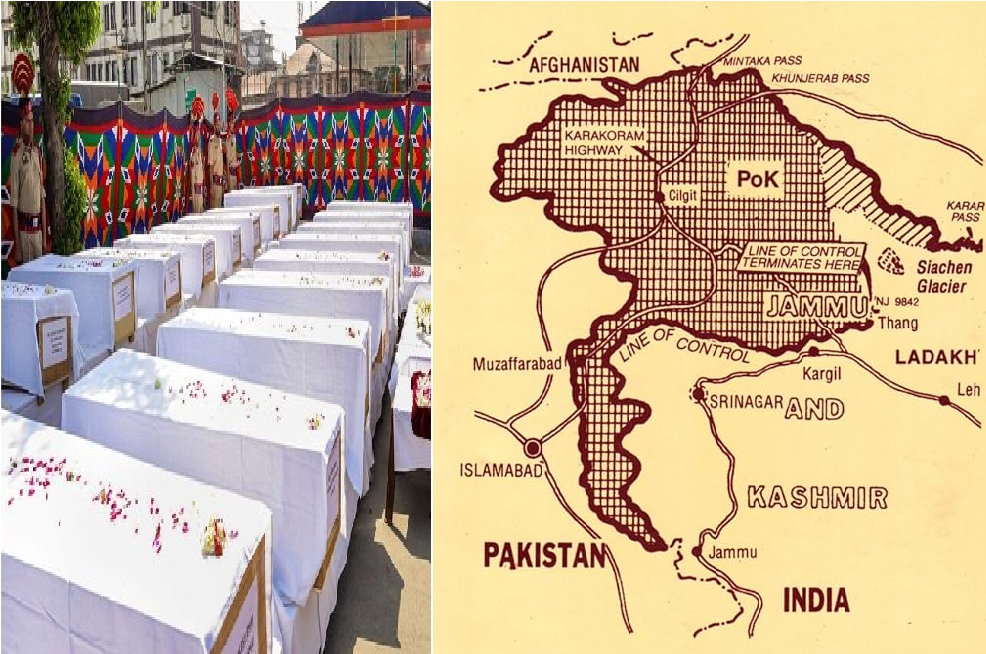
- The dastardly terrorist attack in Pahalgam has left a deep, traumatic wound in the psyche of the nation, similar to the sorrow and angst felt in the aftermath of the Pulwama suicide blast in 2019 targeting a convoy of the CRPF, resulting in 40 casualties.
- As shown by the wars in Ukraine and Gaza, today’s wars are marked more by attrition and resilience of the actors rather than quick victories.
- Sanctions are bound to be much harder, along with the concomitant diplomatic isolation and negative implications on India’s economic trajectory, as well as its desire to become a manufacturing and innovation hub in partnership with the US and Europe.
- While the current pressure on the Indian government and military establishment to undertake appropriate action is understandable, actions cannot be determined by emotions alone without taking into consideration the practicalities and implications of the same.
The dastardly terrorist attack in Pahalgam, which left 26 dead, has imprinted a deep, traumatic wound in the psyche of the nation, similar to the sorrow and angst felt in the aftermath of the Pulwama suicide blast in 2019 targeting a convoy of Central Reserve Police Force (CRPF), resulting in 40 casualties. The nationwide anger was further fuelled by the involvement of Pakistan-backed terrorist outfit Lashkar-e Taiba’s proxy, The Resistance Front (TRF), which had reportedly carried out religious profiling of the victims before killing them on the spot. While the Indian government announced a slew of measures as a response, including keeping the Indus Water Treaty (IWT) in abeyance, these have not been enough to satisfy the popular demands for counteraction and retribution. Among such demands on the public front were calls for military operations ranging from full-fledged war to the re-taking of Pakistan-Occupied Kashmir (Pok) and its eventual merger with India.
The PoK has continued to feature in the Indian national consciousness not only as a reminder of the folly of the 1947-48 war with Pakistan often evoking charged emotions and sentiments, but also because of the geostrategic and other advantages offered by the terrain of the region as well as locations such as the Haji Pir Pass in combat operations against Pakistan based troops and proxies. While rhetoric surrounding the retaking of PoK have often featured in the speeches of politicians and occasionally even ministers, yet the fallout from the above incident and the raking up of emotions across the country have led to a charged resurgence of the PoK and appearing to mount pressure on the government to do good on its claims vis-a vis the latter. Although the government’s official stance remains that it is considering ‘all options on the table’, including kinetic action, a military offensive aimed at re-taking PoK or any other such campaign of similar magnitude will have to be executed keeping in view the larger regional and global geopolitical landscape. Also taken into consideration should be the changed nature of warfare as has been witnessed in the theatres of Ukraine and Gaza.
The foremost factor looming large over India’s PoK ambitions is Islamabad’s ‘iron brother’ China. In addition to backing Pakistan’s right to safeguard its security and sovereignty as well as the latter’s demand for an ‘impartial investigation’ into the attack, Beijing has continued with its tacit support for Islamabad even during the framing of the UN Security Council (UNSC) Statement on Pahalgam. Most importantly, PoK constitutes an area of immense importance for China concerning the China Pakistan Economic Corridor (CPEC) passing through the region, especially Gilgit and Baltistan, connecting the province of Xinjiang with the Arabian Sea port of Gwadar. Loss of Pok would disrupt Beijing’s long-term ambitions of having, through the CPEC, an alternative access to the Indian Ocean, bypassing the Straits of Malacca, as well as the prestige cost to the Belt and Road Initiative (BRI) of which CPEC constitutes a vital part. Besides, the 1963 China-Pakistan border deal, leading to the illegitimate cessation of Shaksgam Valley of Pok by Islamabad to Beijing and coupled with Chinese occupation of Aksai Chin, has made the latter the ‘third party’ to any calculation involving the Pok. Hence, any change in the status quo of the region by India is bound to invite a Chinese response and action given the latter’s stakes. While Beijing’s response might not take the form of overt military intervention, it might ramp up pressure along the Line of Actual Control (LAC) or unleash its arsenal of grey warfare tactics, including weaponising the water of Yarlung Tsangpo or Brahmaputra, targeting India’s Northeast (NE).
Regarding NE India, one must also not lose sight of the challenge posed by a hostile post-Hasina Bangladesh. This challenge on India’s eastern frontier has been further enhanced by the deepening of ties, especially military exchange and cooperation between Pakistan and Bangladesh, as well as the increasing convergence between Dhaka and Beijing, leading to the formation of a China-Pakistan-Bangladesh triangle aimed at containing India. In such a context, Bangladeshi remarks on the ‘landlocked nature of India’s Northeast’ and alleged Chinese plans of construction of an airfield in Lalmonirhat in northwestern Bangladesh close to the Indian strategic Siliguri Corridor or Chicken’s Neck cannot but be taken seriously as a sign of belligerent intentions and a potential ‘third’ battle front. Also of concern is the attempt by the infamous Pakistani Inter-Services Intelligence (ISI) to strike root on Bangladeshi soil, which might be used to foment trouble in NE at a time when the region is faced with ethnic strife as in Manipur and an unstable Myanmar on its borders. It will not be far-fetched to assume that Islamabad and Beijing might activate the ‘third front’ on Bangladesh to mount pressure from the east in case of an Indian military action on the west.
On the international front, while India has received messages of consolation and support from the wider international community, such as Russia, Israel, the Gulf countries and even Iran, New Delhi should remain wary of Pakistan’s other friend on the global stage− Turkey. Not only because of Ankara’s insistent support to Islamabad’s position on Kashmir in international fora, but also because of the latter’s assistance in bolstering Pakistani defence and cyber capabilities, as well as Bangladesh. In the case of any Indian military action on PoK, Turkish assistance to Pakistan would not only come in the form of military sales and supplies, but also diplomatic support at the UN where Ankara, along with Beijing, would call upon the international community to condemn ‘Indian aggression’ while drumming up support to pass resolutions in favour of Islamabad’s ‘right to defend itself and respond to the above aggression’ thereby exhibiting Pakistan as the victim as well as trying to isolate India on the world stage as an aggressor or ‘rogue’ state. Not to mention China’s complicity as a permanent member of the UNSC.
Coming to the larger diplomatic front, while one can look up to the US in light of the recent strategic convergence between New Delhi and Washington, yet President Donald Trump’s erratic statements terming the Kashmir conflict as 1500 years old as well as underlining his ‘closeness to India and Pakistan’ – framing New Delhi (victim) and Islamabad (aggressor) on an equal footing− instead of outright condemnation, does not exude much confidence. Also to be taken into account is Pakistan’s continued value (for whatever reasons) in the US’s South Asia strategy as reflected in Trump’s 397 million USD military aid to Islamabad. However, the most important constraint is the unpredictability and transactionalism inherent in Trump’s approach to diplomacy and especially conflict mediation, which are being witnessed in his attempts to broker peace in Ukraine and West Asia. One can only wonder at the kind of ‘deals’ which might be exacted from both New Delhi and Islamabad in return for American support to their respective positions. Another facet to watch out for is Trump’s penchant to ‘ending wars quickly’ and being hailed as a ‘peacemaker’ irrespective of the nature of the outcome and possible consequences which might not bode well as India might be forced to concede its strategic gains in PoK under pressure from Trump to secure a ‘quick deal’.
Finally, as shown by Ukraine and Gaza, today’s wars are marked more by attrition and resilience of the actors rather than quick victories. In other words, the definition of victory in today’s wars are defined more by the ability of the countries to withstand pressure on multiple fronts including economic, diplomatic, technological and information among others in the face of non-conventional and non-kinetic methods of warfare such as sanctions, diplomatic isolation, and other kinds of external pressure. This has been exemplified by both Russia and Iran, who have continued to stand strong in the face of US-led sanctions and pressure regime.
Now, the question to ask is whether the Indian economy and society are willing and capable of withstanding the multi-front pressure, including sanctions, in the aftermath of a military action targeting the Pok, which would inevitably draw in the Pakistani army. Also, underlining the fragility of the situation is that the above would constitute a conflict between nuclear-powered adversaries, which would further send the international community into a panic and result in heightened efforts to compel the parties to back down from the brink of a possible nuclear fallout, especially by both the US and China. This would result in the imposition of sanctions and diplomatic pressure on both India and Pakistan, similar to the 1998 sanctions imposed on both New Delhi and Islamabad after the conduct of nuclear tests by the duo. Given the advancements made by New Delhi in its nuclear arsenal and capabilities, the sanctions are bound to be much harder, along with the concomitant diplomatic isolation and negative implications on India’s economic trajectory, as well as its desire to become a manufacturing and innovation hub in partnership with the US and Europe. These are questions that can be best answered by the economic leadership and thinkers in the country.
While the current pressure on the Indian government and military establishment to undertake appropriate action in response to the reprehensible act and ameliorate the public conscience is understandable, actions cannot be determined by emotions alone without taking into consideration the practicalities and implications of the same. Even if New Delhi decides to move forward with the retaking of Pok, it must do so keeping in sight the factors mentioned above and after having ensured the resilience and withstanding capacity of the country as well as the support of the society as a whole to face down the repercussions. As was said by Hans Morgenthau, “Realism considers prudence− prudence-the weighing of the consequences of alternative political actions-to be the supreme virtue in politics…Political realism… requires a sharp distinction between the desirable and the possible…what is possible under the concrete circumstances of time and place”.
Anuraag Khaund is a PhD scholar in International Politics at the School of International Studies, Central University of Gujarat (CUG). He has published opinion pieces in The Diplomat, Kashmir Observer, Modern Diplomacy, and Deccan Herald, and writes the column ‘Yours Geopolitically Khaund’ for the Global Strategic & Defence News (GSDN). Views expressed are the author’s own.
